Kadó
People tend to feel one of two ways about licorice—you either love it or can’t stand the stuff. Berliners of the former persuasion head to the Graefekiez’s Kadó to satisfy their cravings. The small, sunny shop is brimming with all things licorice—nostalgic tins, licorice liquor, licorice cooking powder, licorice tea and cookbooks with recipes for everything from licorice desserts to licorice-infused pasta.
Named after the French word for gift (cadeau) the ambience of Kadó fuses old-fashioned pharmacy with a bygone era candy store. Apothecary-style glass jars line the walls, presenting over 400 types of licorice from across the globe. The sweets are weighed on antique scales and purchases are tallied on a creaky wooden register that actually dings as the price pops up.
On any given afternoon a steady flow of customers stream in and out of the space while owners Ilse Böge and her husband Frank Büttner stand by ready to give recommendations based the customer’s current state of sweet tooth. One moment you might sample something soft, sweet and gummy and in the next bite your palette is flooded with a taste saltier than a surprise gulp of ocean water.
In front of the saltier varieties, small “Only for Adults” signs draw a chuckle. The notices aren’t because the candies take the form of skulls, spiders or crunchy little rocks; rather it’s a warning that too much licorice can raise blood pressure. With this gentle admonition in mind the health benefits, and why physicians have recommended licorice for millennia, should be kept in mind. The dark candies were used to help quench soldier’s thirst on the long dry marches of Alexander the Great. Egyptians used it as a cure-all and it was found in the tomb of King Tut, the Brahmins of India recommended it for mental health, and Hindus believed licorice increased sexual vigor when drunk with milk and sugar. In Europe it’s been widely prescribed since the 18th century for sore throats and stomach ailments.
Traditionally the licorice root can be found in warm southern climates like Sicily or Calabria, but if you’re the adventurous type you’ll be tempted to try variations by country. The tastes of Scandinavia and Holland tend to be salty, while Germany produces soft, sweet and mild flavors. Italy and France have a touch of natural herbs such as thyme or anise, whereas Icelandic licorice has a hint of chocolate. Great Britain is distinguished by their Pontefract confections and Spain represents with pure and mint qualities.
Kadó’s specialty, ginger licorice produced by a small Dutch manufacturer, was years in the making. It was finally released last year with mouthwatering results. No matter what your taste, Kadó is worth a visit. You won’t spend hours there but you will step out into one of Berlin’s burgeoning neighborhoods with a black tongue and a little brown paper licorice filled bag.
– Alicia Reuter

- Photography by Ilse Böge

